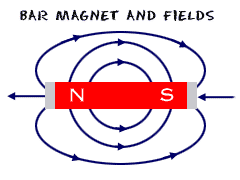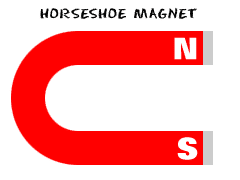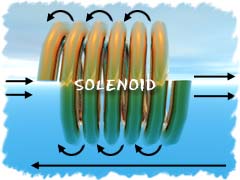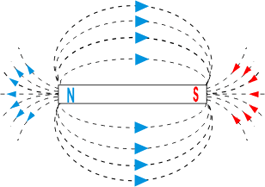Magnetism
Domain Theory of Magnetism
Magnets are made of iron, nickel or cobalt. In a magnet, there are groups of atoms called domains, each of which behaves like a tiny magnet.
In demagnetised steel, the domains point in different directions and cancel one another out. In magnetised steel, the domains are pulled about until they point in the same direction, thus reinforcing each other.
Demagnetised

Magnetised

- Properties of Magnets
- There are 2 ends or poles of the magnet (north and south)
- The north pole of a suspended magnet points north. The south pole of a suspended magnet points south.
- Unlike poles attract each other (e.g. north and south). Like poles repel each other (e.g. north and north, south and south).

- Magnets attract objects made of iron.
- Repulsion between a magnet and another object indicates that the other object is also a magnet.
- A magnet that is dropped or heated may lose its magnetism due to non-aligned or 'scrambled' domains.
- A magnetic field is the region around a magnet where lines of magnetic force point from north pole to south pole.
 Magnetic Field of a Bar Magnet
Magnetic Field of a Bar Magnet
- 4 Ways to Make a Magnet
- Stroke the magnetic material (e.g. screwdriver or metal ruler) with a bar magnet in the same direction
- Hold the magnetic material near a bar magnet for a long period of time
- Hold the magnetic material in a north-south direction, and strike it 30 or more times with a hammer
- Make an electromagnet by winding some plastic-coated wire around the magnetic material and connecting the wire to a battery
COMPLETE HAND-OUT MAGNETISM -

Magnetised  |


What is a Magnet?
 A magnet is an object or a device that gives off an external magnetic field. Basically, it applies a force over a distance on other magnets, electrical currents, beams of charge, circuits, or magnetic materials. Magnetism can even be caused by electrical currents.
A magnet is an object or a device that gives off an external magnetic field. Basically, it applies a force over a distance on other magnets, electrical currents, beams of charge, circuits, or magnetic materials. Magnetism can even be caused by electrical currents.While you might think of metal magnets such as the ones you use in class, there are many different types of magnetic materials. Iron (Fe) is an easy material to use. Other elements such as neodymium (Nd) and samarium (Sm) are also used in magnets. Neodymium magnets are some of the strongest on Earth.
Different Types of Magnets
 There are many different types of magnets. Permanent magnets never lose their magnetism. There are materials in the world that are called ferromagnetic. Those materials are able to create and hold a specific alignment of their atoms. Since many atoms have a magnetic moment (tiny magnetic field), all of the moments can add up to create a magnet. Scientists use the word hysteresis to describe the way the atoms stay aligned.
There are many different types of magnets. Permanent magnets never lose their magnetism. There are materials in the world that are called ferromagnetic. Those materials are able to create and hold a specific alignment of their atoms. Since many atoms have a magnetic moment (tiny magnetic field), all of the moments can add up to create a magnet. Scientists use the word hysteresis to describe the way the atoms stay aligned.Most of the magnets you see around you are man-made. Since they weren't originally magnetic, they lose their magnetic characteristics over time. Dropping them, for example, weakens their magnetism; as does heating them, or hammering on them, etc.
There are also air-core magnets. Air-core magnets are created by current flowing through a wire. That current produces the magnetic field. You create an air-core magnet by wrapping miles of wire around in a doughnut shape (toroid). When you send current through the wire, a magnetic field is created inside of the doughnut. Scientists sometimes use air-core magnets to study fusion reactions.
 Electromagnets are different because they have a ferromagnetic material (usually iron or steel) located inside of the coils of wire. The core isn't air, it is something that aids in producing magnetic effects, so electromagnets are typically stronger than a comparable air-core magnet. Air-core and electromagnets can be turned on and off. They both depend on currents of electricity to give them magnetic characteristics. Not only can they be turned on and off, but they can also be made much stronger than ordinary magnets. You might see an electromagnet at work in a junkyard lifting old cars off the ground.
Electromagnets are different because they have a ferromagnetic material (usually iron or steel) located inside of the coils of wire. The core isn't air, it is something that aids in producing magnetic effects, so electromagnets are typically stronger than a comparable air-core magnet. Air-core and electromagnets can be turned on and off. They both depend on currents of electricity to give them magnetic characteristics. Not only can they be turned on and off, but they can also be made much stronger than ordinary magnets. You might see an electromagnet at work in a junkyard lifting old cars off the ground.REVIEW:

 Magnetism is an invisible force or field caused by the unique properties of certain materials. In most objects, electrons spin in different, random directions. This causes them to cancel each other out over time. However, magnets are different. In magnets the molecules are uniquely arranged so that their electrons spin in the same direction. This arrangement of atoms creates two poles in a magnet, a North-seeking pole and a South-seeking pole.
Magnetism is an invisible force or field caused by the unique properties of certain materials. In most objects, electrons spin in different, random directions. This causes them to cancel each other out over time. However, magnets are different. In magnets the molecules are uniquely arranged so that their electrons spin in the same direction. This arrangement of atoms creates two poles in a magnet, a North-seeking pole and a South-seeking pole. Magnets Have Magnetic Fields
The magnetic force in a magnet flows from the North pole to the South pole. This creates a magnetic field around a magnet.
Have you ever held two magnets close to each other? They don't act like most objects. If you try to push the South poles together, they repel each other. Two North poles also repel each other.
Turn one magnet around, and the North (N) and the South (S) poles are attracted to each other. Just like protons and electrons - opposites attract.
Where do we get magnets?
Only a few materials have the right type of structures to allow the electrons to line up just right to create a magnet. The main material we use in magnets today is iron. Steel has a lot of iron in it, so steel can be used as well.
The Earth is a giant magnet
At the center of the Earth spins the Earth's core. The core is made up of mostly iron. The outer portion of the core is liquid iron that spins and makes the earth into a giant magnet. This is where we get the names for the north and south poles. These poles are actually the positive and negative poles of the Earth's giant magnet. This is very useful to us here on Earth as it lets us use magnets in compasses to find our way and make sure we are heading in the right direction. It's also useful to animals such as birds and whales who use the Earth's magnetic field to find the right direction when migrating. Perhaps the most important feature of the Earth's magnetic field is that it protects us from the Sun's solar wind and radiation.
The Electric Magnet and Motor
Magnets can also be created by using electricity. By wrapping a wire around an iron bar and running current through the wire, very strong magnets can be created. This is called electromagnetism. The magnetic field created by electromagnets can be used in a variety of applications. One of the most important is the electric motor.

MAGNETS - VIDEO